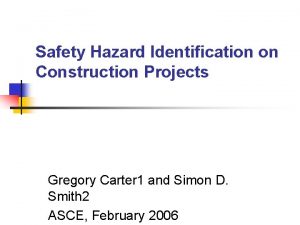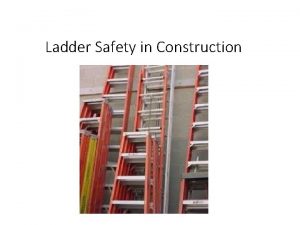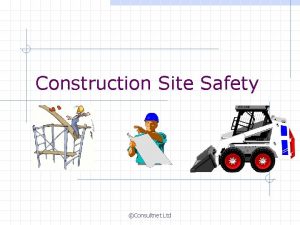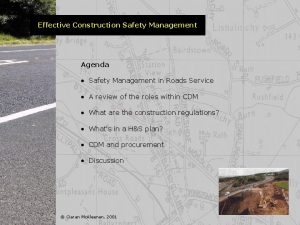Safety Management and Safety Culture Among Small Construction


























- Slides: 26

Safety Management and Safety Culture Among Small Construction Firms CPWR Second Quarterly Data Report, 2016

Characteristics of construction firms

1. Size of construction firms, 2012 versus 2015 2012 (n=262) 35% 31, 8% 28, 5% 30% % of firms 2015 (n=252) 25% 22, 0% 20% 15% 10% 12, 6% n=75 n=80 17, 1% 19, 8% 19, 4% 21, 0% 15, 9% 11, 5% n=33 5% n=45 n=40 n=29 n=58 n=50 n=51 n=53 100 -499 500+ 0% 1 -9 10 -49 50 -99 Firm size (Number of employees) Source: Dodge Data & Analytics, 2012 and 2015 Construction Safety Management Survey. Calculations by the authors.

2. Type of companies by firm size, average of 2012 and 2015 % of companies 38, 7% General Contractor/General Construction 49, 4% 48, 1% 1 -9 58, 7% 10 -49 51, 6% 52, 3% Specialty Trade Construction Subcontractor 35, 3% 38, 9% 25, 0% 50 -99 100 -499 500+ Construction management/Design/Build firms 8, 1% 7, 7% 14, 1% 12, 0% 16, 3% Source: Dodge Data & Analytics, 2012 and 2015 Construction Safety Management Survey. Calculations by the authors.

3. Type of projects worked on in the last three years, small vs. large firms, average of 2012 and 2015 % of firms 74, 2% 76, 0% Low-Rise Commercial Low-Rise Residential 34, 6% Industrial Buildings 35, 5% High-Rise Commercial 65, 4% 16, 1% Non-Building Projects * 14, 5% High-Rise Residential 14, 5% Transportation Buildings ** 51, 6% 12, 9% 73, 1% 39, 4% Small: 1 -9 employees 49, 0% 46, 2% * Highway, street , and bridge; water and sewer; oil and gas pipeline; etc. **Airports, train stations, etc. Source: Dodge Data & Analytics, 2012 and 2015 Construction Safety Management Survey. Calculations by the authors. Large: 500+ employees

Practices Used on Projects to Promote Safety

4. Type of safety practices among construction firms, 2012 versus 2015 % of firms Equipment and protection Personal Protective Equipment (PPE) 2012: N. A. 72, 2% 2012: N. A. 70, 2% 39, 9% Organizational safety practices 27, 0% Prevention through design (Pt. D) Safety policies 16, 4% 51, 6% 40, 5% 2012 25, 4% Source: Dodge Data & Analytics, 2012 and 2015 Construction Safety Management Survey. Calculations by the authors. 2015

5. Safety practices involving equipment and protection by firm size, 2015 100% 90% 84, 0% % of firms 80% 70, 0% 67, 5% 10 -49 50 -99 86, 8% 72, 2% 60% 50% 40% 37, 9% 30% 20% 10% 0% 1 -9 100 -499 500+ Firm size (Number of employees) Source: Dodge Data & Analytics, 2015 Construction Safety Management Survey. Calculations by the authors. Total

6. Personal Protective Equipment (PPE) use by firm size, 2015 100% 84, 0% 88, 7% % of firms 80% 60% 70, 2% 55, 2% 60, 0% 40% 20% 0% 1 -9 10 -49 50 -99 100 -499 Firm size (Number of employees) 500+ Source: Dodge Data & Analytics, 2015 Construction Safety Management Survey. Calculations by the authors. Total

7. Organizational safety practices, small versus large firms, average of 2012 and 2015 % of firms 96, 2% Include jobsite workers in safety process 72, 6% 95, 2% Maintain open door policy for workers to report hazards, incidents, and concerns 67, 7% 93, 3% Designate competent project safety personnel Do prompt/thorough near miss and incident investigations Conduct job hazard/job safety analysis before construction begins 54, 8% 93, 3% 27, 4% 92, 3% 29, 0% Large: 500+ employees Small: 1 -9 employees Source: Dodge Data & Analytics, 2012 and 2015 Construction Safety Management Survey. Calculations by the authors.

8. Percentage of firms with five organizational safety practices by firm size, average of 2012 and 2015 90% 81, 7% 80% 71, 3% % of firms 70% 60% 50% 40, 0% 40% 30% 20% 10% 45, 7% 21, 3% 9, 7% 0% 1 -9 10 -49 50 -99 100 -499 500+ Firm size (Number of employees) Source: Dodge Data & Analytics, 2012 and 2015 Construction Safety Management Survey. Calculations by the authors. Total

9. Prevention through Design (Pt. D) to promote safety by firm size, average of 2012 and 2015 70% 59, 6% % of firms 60% 46, 3% 50% 40% 33, 7% 30, 6% 30% 20% 17, 4% 12, 9% 10% 0% 1 -9 10 -49 50 -99 100 -499 500+ Firm size (Number of employees) Source: Dodge Data & Analytics, 2012 and 2015 Construction Safety Management Survey. Calculations by the authors. Total

10. Safety policies, small versus large firms, average of 2012 and 2015 % of firms 94, 2% Develop site specific safety and health plan 53, 2% 88, 5% Have measurable safety goals and objectives 37, 1% Establish site-specific training programs for supervisors, jobsite workers, and subcontractors Offer safety incentives 80, 8% 33, 9% 60, 6% 9, 7% Large: 500+ employees Small: 1 -9 employees Source: Dodge Data & Analytics, 2012 and 2015 Construction Safety Management Survey. Calculations by the authors.

11. Percentage of firms with four safety policies by firm size, average of 2012 and 2015 60% 50, 0% % of firms 50% 40% 33, 3% 30% 20, 0% 20% 10% 24, 1% 10, 3% 4, 8% 0% 1 -9 10 -49 50 -99 100 -499 Firm size (Number of employees) 500+ Source: Dodge Data & Analytics, 2012 and 2015 Construction Safety Management Survey. Calculations by the authors. Total

Safety Culture Indicators

12. Management commitment to safety and health, small versus large firms, 2015 % of firms applied this to more than 70% of projects 77, 4% Safety & health expectations are clearly defined 44, 8% 73, 6% Safety & health is a top agenda item in all meetings 24, 1% 52, 8% Management participates in all Safety & health meetings on the jobsite Safety & health data are used for improvement 34, 5% 50, 9% 6, 9% Prevention through design is practiced Large: 500+ employees 43, 4% 24, 1% Small: 1 -9 employees Source: Dodge Data & Analytics, 2015 Construction Safety Management Survey. Calculations by the authors.

13. Safety and health are fundamental company values, small versus large firms, 2015 % of firms applied this to more than 70% of projects Safety & health is factored into planning and bidding jobs 64, 2% 41, 4% 56, 6% Safety & health mentoring is encouraged 34, 5% Large: 500+ employees Small: 1 -9 employees Source: Dodge Data & Analytics, 2015 Construction Safety Management Survey. Calculations by the authors.

14. Safety and health accountability, small versus large firms, 2015 % of firms applied this to more than 70% of projects 83, 0% Everyone is held accountable for safety Near-misses are taken seriously and investigated External safety & health audits are used Large: 500+ employees 72, 4% 75, 5% 34, 5% 49, 1% 24, 1% Small: 1 -9 employees Source: Dodge Data & Analytics, 2015 Construction Safety Management Survey. Calculations by the authors.

15. Supervisory leadership, small versus large firms, 2015 % of firms applied this to more than 70% of projects 75, 5% Supervisors lead by example Subcontractors are monitored on safety practices Subcontractors are mentored on safety practices Large: 500+ employees 79, 3% 60, 4% 37, 9% 37, 7% 34, 5% Small: 1 -9 employees Source: Dodge Data & Analytics, 2015 Construction Safety Management Survey. Calculations by the authors.

16. Jobsite worker involvement, small versus large firms, 2015 % of firms applied this to more than 70% of projects Workers are encouraged to report unsafe conditions to management 69, 0% Workers are given stop-work authority 55, 2% Workers are involved in job-hazard analysis Large: 500+ employees 64, 2% 37, 9% Workers are asked for input on site safety & health conditions Workers are involved in safety & health planning 81, 1% 44, 8% Workers are encouraged to report nearmisses to management 56, 6% 58, 6% 24, 1% 84, 9% 43, 4% Small: 1 -9 employees Source: Dodge Data & Analytics, 2015 Construction Safety Management Survey. Calculations by the authors. 79, 3%

17. Safety and health communication, small versus large firms, 2015 % of firms applied this to more than 70% of projects Safety and health policies are coordinated with all subcontractors Managers regularly engage with workers one-on-one Large: 500+ employees 66, 0% 34, 5% 37, 7% 58, 6% Small: 1 -9 employees Source: Dodge Data & Analytics, 2015 Construction Safety Management Survey. Calculations by the authors.

18. Owner/client involvement in safety and health, small versus large firms, 2015 % of firms applied this to more than 70% of projects 43, 4% Owners support safety and health audits 20, 7% 28, 3% 31, 0% Owners monitor onsite safety & health performance Owners require safety and health precertification of all bidders 28, 3% 6, 9% 26, 4% Owners participate in safety & health activities Owners provide incentives for safety and health performance Large: 500+ employees 34, 5% 17, 0% 10, 3% Small: 1 -9 employees Source: Dodge Data & Analytics, 2015 Construction Safety Management Survey. Calculations by the authors.

Safety and Health Training

19. General safety and health training by firm size, 2015 % high (71% or more) Safety & health training is provided for supervisors and jobsite workers Supervisors are required to have safety & health leadership training All employees receive orientation training when starting work on a new site 55, 2% 47, 5% 48, 3% 42, 5% 70, 0% 76, 0% 84, 9% 1 -9 10 -49 62, 5% 64, 0% 50 -99 77, 4% 100 -499 500+ 55, 2% 60, 0% 72, 0% Source: Dodge Data & Analytics, 2015 Construction Safety Management Survey. Calculations by the authors. 96, 2%

20. OSHA training by firm size, average of 2012 and 2015 % Implemented or practiced 53, 2% All jobsite workers are required to have basic safety & health training (OSHA 10 -hour) 63, 2% 1 -9 80, 0% 10 -49 71, 3% 50 -99 78, 8% 100 -499 500+ 56, 5% 72, 9% Supervisors are required to have basic safety & health training (OSHA 30 -hour) 84, 7% 87, 0% 93, 3% Source: Dodge Data & Analytics, 2012 and 2015 Construction Safety Management Survey. Calculations by the authors.

21. Frequency of general safety and health training, small versus large firms, average of 2012 and 2015 Small: 1 -9 employees Large: 500+ employees 4, 8% 6, 5% 15, 4% 35, 5% 19, 4% 18, 3% 51, 9% 14, 5% 9, 6% 24, 2% Only when hired or required Annually Biannually Quarterly Source: Dodge Data & Analytics, 2012 and 2015 Construction Safety Management Survey. Calculations by the authors. Other
 Basic safety orientation
Basic safety orientation Basic safety construction site safety orientation
Basic safety construction site safety orientation Mathematical challenges for able pupils
Mathematical challenges for able pupils Small group stages formats and culture
Small group stages formats and culture Material culture example
Material culture example Continuous culture and batch culture
Continuous culture and batch culture Difference between american culture and indian culture
Difference between american culture and indian culture Stroke culture method
Stroke culture method Folk culture and popular culture venn diagram
Folk culture and popular culture venn diagram Examples of mass culture
Examples of mass culture Urease test
Urease test Folk culture and popular culture venn diagram
Folk culture and popular culture venn diagram Anaerobic gaspak
Anaerobic gaspak Describe lawn culture and surface plating
Describe lawn culture and surface plating Surface culture deep culture and esol
Surface culture deep culture and esol Tceq small construction site notice
Tceq small construction site notice Adrian holliday small cultures
Adrian holliday small cultures Sociologists define a symbol as
Sociologists define a symbol as Batch culture vs continuous culture
Batch culture vs continuous culture Individualistic culture vs. collectivist culture
Individualistic culture vs. collectivist culture Sub culture group
Sub culture group Inert organizational culture
Inert organizational culture Characteristics of quality culture
Characteristics of quality culture Limited access zones around masonry wall
Limited access zones around masonry wall Health and safety executive construction
Health and safety executive construction Promoting a positive health and safety culture
Promoting a positive health and safety culture Gregory carter
Gregory carter


















































